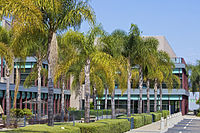- Cymer, Inc.
-
Cymer, Inc. Type Public Traded as NASDAQ: CYMI Industry Semiconductor Equipment Founded 1986 Headquarters San Diego, California Key people Robert P. Akins, Ph.D. (Founder/Chairman/CEO)
Richard L. Sandstrom, Ph.D. (Founder/SVP/CTA)
Edward J. Brown, Jr. (President/COO)
Paul Bowman (SVP/CFO)Products DUV Light Sources, EUV Light Sources, and service products for the semiconductor and flat panel display industries Revenue $534M (2010) Employees Approximately 950 (February 2011) Website www.cymer.com Cymer, Inc. is the largest supplier of deep ultraviolet (DUV) light sources used by chipmakers to pattern advanced semiconductor chips or integrated circuits. The company was founded in 1986 and maintains its global headquarters in San Diego, California. It is listed on the NASDAQ under the ticker symbol CYMI. The photolithography process to pattern semiconductor chips primarily uses DUV light at wavelengths of 248 nanometers (nm) and 193 nm. Cymer provides its customers with DUV light sources including krypton fluoride (KrF) light sources that generate light at 248 nm wavelength and argon fluoride (ArF) light sources that generate light at 193 nm wavelength. Cymer has installed over 3,600 light sources as of March 2011. Cymer supplies light sources to all three DUV lithography scanner manufacturers—ASML Holding, Nikon Corporation and Canon Inc.—which in turn integrate the Cymer light source into their scanners and supply their tools to more than 85 chipmakers around the world in all three major industry segments including memory, logic, and foundry. The company supports its chipmaker customers from more than two dozen offices in eleven countries in North America, Asia, and Europe, providing these customers with consumables and replacement parts and access to Cymer trained resources in service, light source technology, and lithography applications. Installed light sources are supported through Cymer’s service and support product offering, OnPulse. The company is developing next-generation light source technology called Laser Produced Plasma (LPP) Extreme Ultraviolet (EUV) light sources. Cymer light source technology is also used in the manufacturing process for liquid crystal display (LCD) and organic light emitting diode (OLED) flat panel displays through TCZ, its display product division.
Contents
Corporate history
Cymer was founded in 1986 by Dr. Robert Akins and Dr. Richard Sandstrom, who met in the mid-1970s in a lab class at the University of California, San Diego. In 1986 the personal computer market opened a door for Akins and Sandstrom to apply their unique laser knowledge for the purpose of semiconductor photolithography.
In the late 1980s, semiconductor companies needed a new, short-wavelength light source to pattern the intricate circuitry necessary to keep pace with Moore’s Law. In 1988 Cymer shipped its first light source for advanced research and development applications to support the development of semiconductor lithography. In 1990 a second-generation light source shipped, and the company quickly progressed, shipping a total of 78 light source systems between 1988 and 1994.
In the mid-1990s, Cymer had established its light sources as a necessary component in the development of advanced semiconductor products, and demand for its light sources began to increase. Meeting this demand, Cymer issued its initial public offering on the NASDAQ in September 1996 under the symbol CYMI. The company’s IPO helped provide the capital Cymer needed to grow manufacturing capacity and service infrastructure as needed to meet the industry’s rapid expansion.
In the dot-com boom of 2000, Cymer sold an annual high of 494 new light source systems, and in 2002 the company shipped its 2000th light source. By the end of the decade, Cymer had shipped over 3,300 KrF and ArF light sources world-wide.
In June 2009 Cymer shipped the world’s first fully integrated LPP EUV lithography light source to ASML Holding in Veldhoven, Netherlands, for integration into its EUV scanner [1]. This new type of light source produces a wavelength of 13.5 nm and will be used to pattern chips for at least the next decade [2].
In July 2005 TCZ was formed as a joint venture between Cymer, Inc. and Carl Zeiss SMT AG to develop and manufacture a silicon crystallization process tool for use in the production of flat panel displays – especially OLED displays. The crystallization tool uses Cymer's light source technology. In January 2010 Cymer announced that it would acquire Carl Zeiss' ownership interest in the Cymer/Zeiss TCZ joint venture, making TCZ a wholly owned Cymer company. Carl Zeiss continues to be a key supply chain partner.
Products/Technology
DUV Products
Cymer’s light sources, which comprise an installed base of more than 3,750 shipped systems, are based on KrF and ArF technology that deliver 248 nm and 193 nm light, respectively. Light at these wavelengths is produced when an electrical discharge is applied to a mixture of gases (Krypton and Fluorine (KrF) or Argon and Fluorine (ArF)). The resulting light is collected and delivered to a scanning exposure tool which is used to pattern silicon wafers. Cymer's DUV product line by technology includes:
Technology Wavelength Product Application ArF Immersion 193 nm XLR 600ix Double patterning lithography, 32nm node and below ArF Immersion 193 nm XLR 500i Immersion lithography, 45nm and 65nm node ArF Immersion 193 nm XLA 400 Immersion lithography, 65 nm node ArF Immersion 193 nm XLA 300 Immersion lithography, 65 nm node ArF Dry 193 nm XLA 105 Dry lithography, 65 nm and 90nm node KrF 248 nm ELS 7010x Dry lithography, 130 nm and 180 nm node Installed Base Products
Light sources installed at chipmaker fabs are maintained through Cymer’s OnPulse support product offering. New light source innovations and feature enhancements are made available through OnPulse and include support from Cymer’s field support organization and IT infrastructure. The OnPulse offering optimizes light source availability and productivity for the chipmaker.
LPP EUV Products
Cymer is developing a new generation of light source to enable advanced lithography beyond the capability of DUV light sources. LPP EUV light sources produce 13.5 nm ultraviolet light by targeting small droplets of molten tin with a pulsed, high-powered CO2 laser [3][4]. The resulting plasma produces the 13.5 nm light which is collected and delivered to a scanner that is used to pattern silicon wafers. EUV light sources will enable photolithography below the 22 nm node and support Moore’s Law.
Silicon Crystallization Process Tool Products
TCZ, Cymer's display equipment product division, is producing a new generation of silicon crystallization process tools for flat panel display manufacturing, including LCD and OLED displays that will be used in cell phones, laptops, and televisions. The crystallization tools use Cymer’s DUV light sources to thermally melt and recrystallize the silicon, producing a poly-crystalline form of silicon with improved electrical properties. Poly-Silicon is used in the manufacturing of high performance transistors that are a critical part of the manufacturing of advanced LCD and OLED displays, which are currently used in applications such as smart phones and OLED televisions. The TCZ crystallization process uses a long, very thin (~5 micrometre) beam that is rapidly scanned across the glass panel, processing glass panels at a high throughput and producing a very uniform poly-silicon crystallized film.
Cymer in the Community
Cymer supports a number of philanthropic organizations and events in San Diego County in five areas.
Education - Co-founders Robert Akins and Richard Sandstrom received their Ph.D.'s from the University of California, San Diego prior to starting Cymer in 1986. Since then Cymer has supported the University and multiple non-profit organizations aimed at promoting excellence in education and in recognition of student scholars from all levels of education.
Health - Through corporate giving and the volunteerism of employees, Cymer supports health foundations that strive to find cures for life-altering diseases.
Culture - Cymer seeks out and supports organizations that foster creativity in the arts and that provide opportunities for the local community to experience multiple forms of creative expression.
Environment - Cymer supports initiatives aimed at responsible disposal of electronic waste and the promotion of alternative approaches that reduce the environmental impact of technology innovation.
Civic - Cymer supports civic initiatives that help provide a safety net for those less fortunate [5] [6].
References
- ^ Shenkenberg, David, Photonics Spectra, October 2009, Taking Semiconductor Manufacturing to the Extreme (online: http://www.photonics.com/Article.aspx?AID=40103)
- ^ Intel Achieves Major Milestones in EUV Lithography Program (online: http://www.intel.com/pressroom/archive/releases/2004/20040802tech.htm)
- ^ Wagner, Christian and Harned, Noreen, Nature Photonics, January 2010, Vol. 4, No. 1, Lithography Gets Extreme, p. 24 – 26 (online: http://www.nature.com/nphoton/journal/v4/n1/full/nphoton.2009.251.html)
- ^ Brandt, David and Farrar,Nigel, Solid State Technology, September 2009, High-power EUV lithography light sources, p. 10 (online: http://www.electroiq.com/index/display/semiconductors-article-display/368295/articles/solid-state-technology/volume-52/issue-9/features/cover-article/high-power-euv-lithography-lightsources-come-of-age.html)
- ^ Cymer Computer Clubhouse Opens at Mission Valley YMCA(online: http://www.computerclubhouse.org/content/cymer-computer-clubhouse-opens-mission-valley-ymca)
- ^ Welcome to the Intel Computer Clubhouse Network (online: http://www.computerclubhouse.org/)
External links
Categories:- Companies listed on NASDAQ
- Lithography (microfabrication)
Wikimedia Foundation. 2010.



